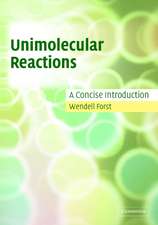Magnetic Isotope Effect in Radical Reactions: An Introduction
Autor Kev M. Salikhoven Limba Engleză Paperback – 2 aug 1996
Preț: 380.25 lei
Nou
Puncte Express: 570
Preț estimativ în valută:
72.76€ • 75.97$ • 60.22£
72.76€ • 75.97$ • 60.22£
Carte tipărită la comandă
Livrare economică 04-18 aprilie
Preluare comenzi: 021 569.72.76
Specificații
ISBN-13: 9783211827840
ISBN-10: 3211827846
Pagini: 160
Ilustrații: VIII, 147 p. 2 illus.
Dimensiuni: 155 x 235 x 8 mm
Greutate: 0.23 kg
Ediția:Softcover reprint of the original 1st ed. 1996
Editura: SPRINGER VIENNA
Colecția Springer
Locul publicării:Vienna, Austria
ISBN-10: 3211827846
Pagini: 160
Ilustrații: VIII, 147 p. 2 illus.
Dimensiuni: 155 x 235 x 8 mm
Greutate: 0.23 kg
Ediția:Softcover reprint of the original 1st ed. 1996
Editura: SPRINGER VIENNA
Colecția Springer
Locul publicării:Vienna, Austria
Public țintă
ResearchCuprins
1 Introduction.- 1.1 Origin of magnetic isotope effect in radical reactions.- 1.2 Favourable conditions for magnetic isotope effect.- 1.3 Some specific features of magnetic isotope effect.- 1.4 What can be gained from magnetic isotope effect?.- 1.5 Basic steps in studying magnetic isotope effect.- 2 Main concepts of the theory of magnetic isotope effect.- 2.1 Macroscopic and microscopic parameters.- 2.2 Radical pairs.- 2.3 Multiplicity and reactivity of radical pairs.- 2.4 The hyperfine coupling.- 2.5 Singlet-triplet transitions in radical pairs induced by the hyperfine interaction.- 2.6 Manifestations of radical pair spin conservation rules in singlet-triplet mixing induced by the isotropic hyperfine coupling.- 2.7 Kinetic equations for radical pair recombination.- 3 Theoretical description of magnetic isotope effect in the Earth’s magnetic field.- 3.1 Radical pairs with one magnetic nucleus (isotropic hyperfine coupling).- 3.2 Radical pairs with magnetically equivalent nuclei (isotropic hyperfine coupling).- 3.3 Radical pairs with many magnetically non-equivalent nuclei (isotropic hyperfine coupling).- 3.4 Magnetic isotope effect induced by the anisotropic hyperfine interaction (paramagnetic relaxation).- 3.5 Magnetic isotope effect in reaction kinetics.- 4 Magnetic isotope effect in the presence of external magnetic fields.- 4.1 Magnetic isotope effect as affected by constant fields.- 4.2 Resonant microwave field pumping.- 5 Experimental evidences of magnetic isotope effect.- 5.1 Enrichment of 13C in dibenzyl ketone during photolysis.- 5.2 Magnetic isotope effect in radiolysis of aromatic hydrocarbon solutions in alkanes.- 5.3 Magnetic isotope effect for heavy elements.- 5.4 Magnetic isotope effect for biradical reaction pathways.- 5.5 Magnetic isotope effect inreaction rates.- 5.6 Isotope enrichment by resonant microwave pumping.- 6 Some perspectives.- References.












